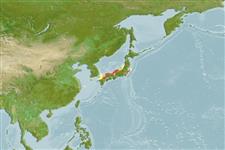>
Perciformes/Zoarcoidei (Eelpouts and pricklebacks) >
Zoarcidae (Eelpouts) > Gymnelinae
Etymology: Andriashevia: Because of Anatoly Petrovich Andriashev, Russian naturalist, 1910.
Eponymy: Professor Dr Anatoly Petrovich Andriyashev (1910–2009) was a Russian marine biologist. [...] (Ref. 128868), visit book page.
Environment: milieu / climate zone / depth range / distribution range
पारिस्थितिकी
समुद्री बाथीड़िमरसल; गहराई सीमा 10 - 1025 m (Ref. 11954). Deep-water
Northwest Pacific: Pacific coast of Japan.
आकार / वज़न / Age
Maturity: Lm ? range ? - ? cm
Max length : 19.3 cm SL पुल्लिंग / अलिंग; (Ref. 11954)
Apparently demersal and associated with large red gorgonian corals, such as Paragorgia. Stomach contents reveal a diet of crustaceans and probably encrusting invertebrates that are hunted among coral branches and the hard substratum of their habitat (Ref. 11954). Minimum depth from Ref. 58018.
Life cycle and mating behavior
परिपक्व अवधि | पुनरुत्पत्ति | मछलीऔ का अंडे देना | अंडे | Fecundity | लार्वा
Anderson, M.E., 1994. Systematics and osteology of the Zoarcidae (Teleostei: Perciformes). Ichthyol. Bull. J.L.B. Smith Inst. Ichthyol. 60:120 p. (Ref. 11954)
IUCN Red List Status (Ref. 130435: Version 2024-2)
Threat to humans
Harmless
Human uses
साधन
Special reports
Download XML
इंटरनेट स्रोत
Estimates based on models
Preferred temperature (Ref.
123201): 0.7 - 15.1, mean 5.7 °C (based on 35 cells).
Phylogenetic diversity index (Ref.
82804): PD
50 = 1.0000 [Uniqueness, from 0.5 = low to 2.0 = high].
Bayesian length-weight: a=0.00110 (0.00042 - 0.00288), b=3.09 (2.86 - 3.32), in cm total length, based on LWR estimates for this (Sub)family-body shape (Ref.
93245).
Trophic level (Ref.
69278): 3.5 ±0.50 se; based on food items.
लौटाव (Ref.
120179): माध्यम, न्यूनतम जनसंख्या दुगनी होने का समय 1.4 - 4.4 वर्ष। (Preliminary K or Fecundity.).
Fishing Vulnerability (Ref.
59153): Low vulnerability (14 of 100).
